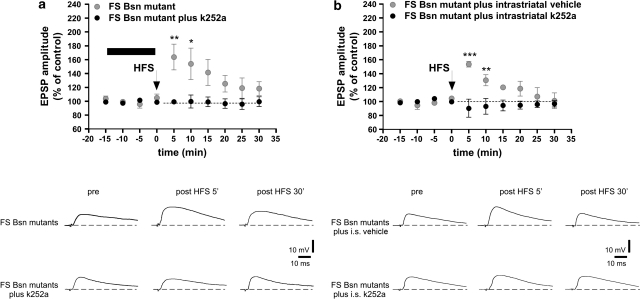Figure 2.
TrkB-dependent short-term plasticity in FS interneurons of Bsn mutant mice. (a) High-frequency stimulation (HFS, arrow) of corticostriatal pathway induced a synaptic potentiation that lasted 10–15 min in FS interneurons recorded intracellularly from corticostriatal slices of Bsn mutant mice. Conversely, 20-min bath application of the TrkB receptor antagonist k252a (200 nM), fully blocked the short-term potentiation (**p<0.01, 5 min, *p<0.05, 10 min after the tetanus, Bsn mutant+k252a vs Bsn mutant, n=6). Bottom panels show example traces of excitatory postsynaptic potential (EPSP) from FS interneuron recorded in Bsn mutants corticostriatal slices (upper traces) and Bsn mutant slices with application of k252a (lower traces). (b) EPSP amplitudes of FS interneurons recorded ex vivo from corticostriatal slices of mice that received intrastriatal administration of k252a (20 μM) or vehicle are shown in the upper panel. Similarly to what observed in naïve mutants, HFS was able to induce a short-term potentiation in mutants injected with vehicle but not in epileptic mice that received intrastriatal k252a (***p<0.001, 5 min, **p<0.01, 10 min after the tetanus, Bsn mutant+vehicle vs Bsn mutant+k252a, n=5). Traces on the bottom represent examples of EPSP of FS interneurons recorded corticostriatal slices from vehicle-injected Bsn mutants (upper traces) and Bsn mutant that received intrastriatal administration of k252a (lower traces).

